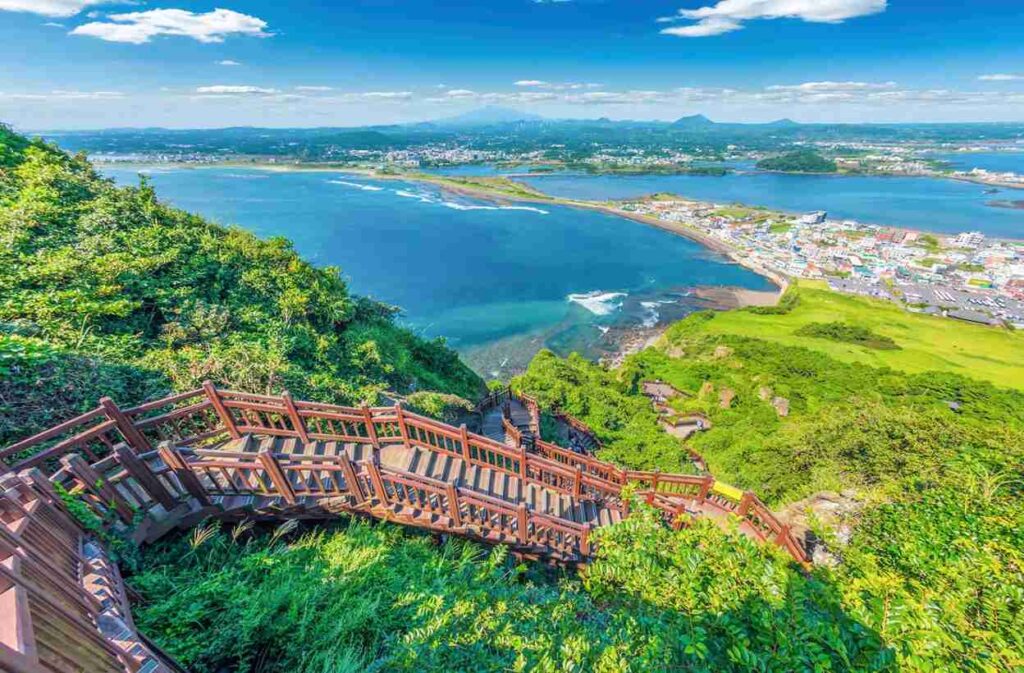Jeju Island, South Korea travel tips
Category
Categories
Popular Articles

Jeju Island, also known as “the Hawaii of South Korea”, is world-renowned for its natural wonders and diverse landscapes, including white sandy beaches, waterfalls, mountains, and volcanic cones. Designated as a UNESCO World Natural Heritage Site in 2007, Jeju is worth visiting for its unique flora and fauna, preserved forests, and magnificent lava tubes. The island boasts a vibrant culture blended with distinctive Korean traditions, excellent dining options, and plenty of adventure activities, making it appealing to all types of travellers.
# Best Time to Visit
Jeju Island’s weather is relatively mild all year round. However, the best time to visit would be during spring (April to June) and autumn (September to November) when the temperatures are pleasant, offering the perfect conditions for sightseeing. Spring is particularly beautiful with cherry blossoms and canola flowers in full bloom, while autumn presents a colorful foliage display. Peak season spans from July to August, bringing scorching heat and crowdy tourist spots. Winter tends to be cooler with sporadic snowfall but offers quiet beaches and off-season discounts.
International festivals and events like the Jeju Fire Festival in March, Cherry Blossom Festival in April, and Jeju Food and Wine Festival in May attract global tourists.
# Climate & What to Pack
Jeju Island has a humid subtropical climate with the cleanest air in Korea. Summers can be hot with temperatures reaching up to 35°C, while winters can get fairly cold with lows nearing 0°C. Rain showers are common in summer. Pack lightweight, breathable clothing, a swimsuit, a hat, sunscreen for summer, and layerable clothing, a scarf, gloves, and a warm jacket for winter. Comfortable walking shoes are essential since Jeju is best explored by foot. Don’t forget an umbrella or raincoat due to occasional unpredicted rainfalls.
# Getting There
Jeju International Airport is directly connected with many major cities worldwide. Upon landing, visitors can easily find taxi services, rent a car, or use public transit to get around the island. South Korea offers visa-free entry to many nationalities for stays under 30 days; however, it’s always best to check the current visa requirements before planning your trip.
# Getting Around Locally
Public transportation consists of buses which cover most areas of the island but can be slightly challenging if you don’t speak Korean. Taxis are widely available and reasonably priced. Renting a car or a scooter is recommended as Jeju Island is large and many attractions are spread out. Some people also choose to rent bicycles or even walk as the roads are flat and beautiful.
# Safety Tips
Jeju Island is generally safe for tourists and has a low crime rate. However, standard precautions should still be taken. Be aware of your belongings in crowded areas, respect local traditions and customs, and do not wander off the walking paths while hiking. Solo female travelers should feel comfortable exploring Jeju, but usual discretion is advised. Korean people are generally polite, so try to reciprocate the courtesy.
# Top Things to Do & See
From hiking the picture-perfect trails of Mount Hallasan, exploring the dramatic Manjanggul Cave, relaxing at Hyeopjae Beach to visiting the traditional Jeju Folk village, the options are endless. Don’t miss out on Cheonjeyeon and Cheonjiyeon waterfalls, Seopjikoji coastline, Teddy Bear museum, and the Love Land theme park for it’s quirky statues.
# Where to Stay
Luxury travelers can consider resorts like the Kensington Jeju or Lotte Hotel Jeju. For mid-range options, try Shilla Stay Jeju or Ramada Jeju City Hall. Budget travellers can find comfort in guesthouses like Slowciti Hostel. Jeju City, Seogwipo City, and Jungmun Resort are the best and most convenient areas to stay.
# Food & Local Cuisine
Experience Korean cuisine with a Jeju twist. Must-try local specialties include Heuk-dwaeji (Jeju Black Pork BBQ), Haemul-ttukbaegi (Seafood Stew), and Omegi-tteok (sweet rice cakes). Halls filled with fresh seafood and local markets such as Dongmun Market are wonderful places to eat.
# Cultural & Practical Tips
The currency is Korean Won (KRW) and English is not widely spoken here, so it would be beneficial to learn a few essential Korean phrases. Tipping is not customary in Korea. Outlets are the same as in mainland Korea – Type C or F Plugs with a standard voltage of 220V. Free wifi is usually available in hotels, cafes and restaurants.
# Sustainable or Responsible Travel Tips
Avoid single-use plastics by carrying a reusable water bottle and shopping bags. Respect wildlife and do not feed or touch animals. Do not stray from marked trails while hiking to prevent damage to the fragile ecosystem.
To end off, a personal tip when visiting Jeju Island: don’t rush your trip. The beauty of Jeju lies in its relaxed pace and tranquil surroundings. Take the time to blend in with the local culture and fully soak in the stunning natural landscapes Jeju has to offer.










